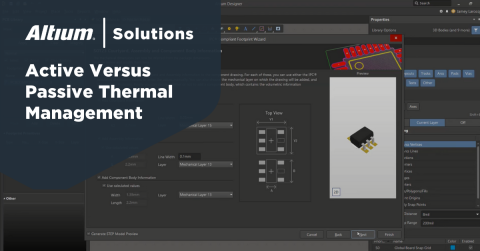Why You Should Use Thermal Prototyping Instead of Simulations

Of all the potential problems with a design, thermal challenges are often the most difficult to predict. It's also the case that you don't notice a thermal management problem until you have already created prototypes and started testing. At that point, the mechanical team has to modify an enclosure, include any cooling mechanisms, and they may need to change many specs in a product. It's too late in the game to start changing specifications after a thermal problem has been created.
What's the solution to all of this? Most EDA vendors will recommend a thermal simulation application, and then they will try to sell you an additional license. We're not here to tell you that thermal simulation applications are bad, but there is a small amount of low-risk work that can be done before creating your PCB design. This is where you should build a thermal prototype, and you should do this before running any thermal simulations on your idealized product.
What Is a Thermal Prototype PCB?
Thermal prototypes are simple test PCBs that allow you to identify thermal management problems in your PCB before finishing a complete electrical and mechanical design. Some components and circuits are examined by building a simple prototype board which will run at the circuit’s intended power levels, and thus its thermal demands can be determined from measurements. You will be able to gain real insight with actual data from your PCB, rather than relying on simulation data.
The other approach to thermal prototyping is in simulation, but this is not always the best path forward. But what exactly is the problem with thermal simulations?
Really, there is nothing wrong with using simulations, the issue is that these applications are complex and expensive. Some thermal simulation applications require PhD-level knowledge and skills to configure and ensure reasonably accurate results. They also require many inputs into the simulation model, which are often determined based on rough estimations. Then there is the cost of simulation software: easy-to-use software tends to come with the biggest price tag.
Obviously, all of this can make thermal simulation applications inaccessible to most designers. Instead, consider building small test boards, which you can push to the limit in terms of power demands and thermal handling. For example, you can use thermal prototypes to:
- Get direct temperature measurements in power electronics circuits
- Experiment with various components in test circuits
- Try a stackup option with your test circuit
- Integrate the thermal prototype with a development board or evaluation kit
What types of circuits should be used in a thermal prototype? I think there are a few good examples of circuits that deserve thermal prototyping:
- Switching power circuits, especially circuits that include discrete gate drives
- Circuits with power MOSFETs, particularly MOSFET arrays
- Certain processors and ASICs
- Temperature-sensitive components, such as high-precision analog interfaces, references, etc.
- Some RF components, namely high frequency power amplifiers
All of these components can generate significant heat, which may demand an active cooling strategy. If the design intent is to manage heat via the enclosure or with another passive strategy, then these devices need to be tested alongside the enclosure to get a full understanding of the cooling approach. Thermal prototypes offer an opportunity to do both and they bring several benefits.
Benefits of Thermal Prototypes Over Thermal Simulation
Thermal prototypes are very useful from multiple perspectives, particularly when looking at cost, design effort, and pre-design evaluation of components.
Lower cost than simulation applications: The cost of a license for a simulation application can be very high. If you're working with an external contractor, that contractor’s time and license provision is not free. Building a test board with the intended circuitry and components lets you quickly test and inspect thermal behavior without the cost and effort involved in building simulations.
Providing a simulation benchmark: Data from thermal prototypes can be used as a benchmark against system-level simulations and as a check on simulation accuracy. These measurements can also be used to get much more accurate parameter estimates for use in thermal simulation models. Then, once you're ready to experiment with active cooling strategies (such as forced airflow), simulations will have a much better match to reality because they will be based on real thermal test data.
Low IP risk: At the end of the day, thermal prototypes will be throwaway boards and will probably not be built a second time after thermal testing. This means your incentive is to build these as cheaply as possible, which might take you to overseas prototyping. These boards are generally very low risk because they rarely reflect the system-level design you want to implement.
Low design risk approaches: Thermal prototypes are often being built because you are trying to qualify the function and thermal demands of a custom circuit. But if you want to qualify a component under test generally, you can always build the thermal prototype board based on the component’s application circuit. Take a look in the component datasheet and replicate the application circuit for a low-risk path forward.
Whether you need to build reliable power electronics or advanced digital systems, use the complete set of PCB design features and world-class CAD tools in Altium Designer®. To implement collaboration in today’s cross-disciplinary environment, innovative companies are using the Altium 365 platform to easily share design data and put projects into manufacturing.
We have only scratched the surface of what’s possible with Altium Designer on Altium 365. Start your free trial of Altium Designer + Altium 365 today.




